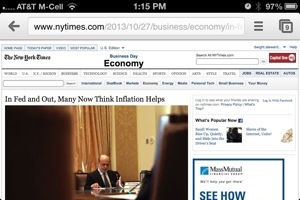Most U.S. workers who lose their jobs are able to find replacement ones quickly according to U.S. Bureau of Labor Statistics data on unemployment duration. The overall percentage of workers finding new employment within in 4 weeks is over 25%. The current percentage is above Great Recession figures and us increasing. Some demographics are finding replacement employment even quicker.
Statistical random sampling messing time records in wage and hour litigation
Many employer time records are still in paper format that is not easily machine readable. Analyzing these data in a wage and hour case typically requires manual entry of the records. However, entering in all the time records is not always feasible. In these situations a statistical random sampling of records can be useful and informative. A solid statistical sampling alows the researcher to calculate error rates which are useful when making inferences concerning the time records.
Some economists and research suggest inflation may be good for the economy
Some economists and recent research support the idea of allowing inflation to increase above its current target of 2%. Proponents argue that increases prices will stimulate growth and increase business profits. Opponents argue that inflation could grow out of control and hurt fixed income investments.
http://www.nytimes.com/2013/10/27/business/economy/in-fed-and-out-many-now-think-inflation-helps.html?hp
Big payday loans make economic sense
Recent payday loan research
Adams, William, Liran Einav, and Jonathan Levin. 2009. “Liquidity Constraints
and Imperfect Information in Subprime Lending.” American Economic
Review 99 (1): 49-84.
Agarwal, Sumit, Paige Marta Skiba, and Jeremy Tobacman. 2009. “Payday
Loans and Credit Cards: New Liquidity and Credit Scoring Puzzles?”
American Economic Review Papers and Proceedings 99 (2): 412-417.
Bhutta, Neil, Paige Marta Skiba, and Jeremy Tobacman. 2012. “Payday Loan
Choices and Consequences.” Vanderbilt University Law School Working
Paper No.12-20.
Chatterjee, Satyajit, Dean Corbae, Makoto Nakajima, and Jose-Victor Rios-
Rull. 2007. “A Quantitative Theory of Unsecured Consumer Credit with
Risk of Default.” Econometrica 75 (6): 173-234.
Edelberg, Wendy. 2004. “Testing for Adverse Selection and Moral Hazard in
Consumer Loan Markets.” FEDS Working Paper No. 2004-09.
Elliehausen, Gregory, and Edward C. Lawrence. 2001. Payday Advance Credit
in America: An Analysis of Customer Demand. Credit Research Center,
Georgetown University.
Gross, David, and Nicholas S. Souleles. 2002. “Do Liquidity Constraints and
Interest Rates Matter for Consumer Behavior? Evidence from the Credit
Card Data.” Quarterly Journal of Economics 117 (1): 149-185.
Karlan, Dean, and Jonathan Zinman. 2009. “Expanding Credit Access: Using
Randomized Supply Decisions to Estimate the Impacts.” Review of Financial
Studies 23 (1): 433-464.
Melzer, Brian T.. 2011. “The Real Costs of Credit Access: Evidence from the
Payday Lending Market.” Quarterly Journal of Economics 126 (1): 517-
555.
Melzer, Brian T., and Donald P. Morgan. 2010. “Competition and Adverse
Selection in a Consumer Loan Market: The Curious Case of Overdraft vs.
Payday Credit.” Unpublished.
Morse, Adair. 2011. “Payday Lenders: Heroes or Villains?” Journal of Financial
Economics 102 (1): 28-44.
Skiba, Paige Marta, and Jeremy Tobacman. 2011. “Do Payday Loans Cause
Bankruptcy?” Vanderbilt University Law and Economics Research Paper
No. 11-13.
Stephens, Melvin. 2008. “The Consumption Response to Predictable Changes
in Discretionary Income: Evidence from the Repayment of Vehicle
Loans.” Review of Economics and Statistics 90 (2): 241-252.
Economists find that larger payday loans lead to LOWER default rates
Economists, Will Dobbie and Paige Mart Skiba, in their paper, use data from Payday lenders in a number states to estimate an econometric model of the payday loan model. Their paper uses borrower income, demographic information, and loan eligibility details to test for moral hazard and adverse selection in the payday loan market.
They find no evidence of moral hazard. A larger loan actually decreases the probability of a default. They find that a $50 larger payday loan leads to a 17 to 33 percent drop in the probability of default. In addition, their results show the relationship between factors such as credit score (-), home owner ship (-), income (-) and age(-) on the probability of default.
Definition: In economic theory, a moral hazard is a situation where a party will have a tendency to take risks because the costs that could incur will not be felt by the party taking the risk
Harley Davidson’s are niche market ; albeit a big niche.
Harley-Davidson Co. said it expects to ship 259,000 to 264,000 motorcycles to dealers and distributors worldwide in 2013….In the U.S., dealers sold 48,529 new motorcycles in the quarter, up 20.1 percent compared to sales of 40,402 motorcycles in the year-ago period.
Revenue from motorcycles grew 10.7 percent to $857 million, compared to revenue of $774 million in the year-ago period….
Is economics a science: Of course it is!
Raj Chetty, a professor at Harvard University, argues that economics is very much a solid science. He argues that while economics has not been able to answer all big picture questions like – what causes recessions and the determinants of growth with perfect certainty. He writes in the NY Times:
Nonetheless, economists have recently begun to overcome these challenges by developing tools that approximate scientific experiments to obtain compelling answers to specific policy questions. …today, the most prominent economists are often empiricists … who focus on testing old theories and formulating new ones that fit the evidence.
This kind of empirical work in economics might be compared to the “micro” advances in medicine (like research on therapies for heart disease) that have contributed enormously to increasing longevity and quality of life, even as the “macro” questions of the determinants of health remain contested.
UT-Austin Economics Department launches rigorous terminal program
The Economics department started a new one-year terminal Master’s degree this past summer. The inaugural class of 40 students began classes in mid-July and, after completing a 10-course, 30-credit curriculum, will graduate in May 2014. The rigorous program is the first of its kind in the state of Texas, and only a handful of similar programs (primarily on the East coast) currently exist.
The MA program at UT was designed for prospective students with any of the following goals:
- Qualifying for jobs in the private or government sector that require greater expertise in economic, analytical, and statistical tools than provided by an undergraduate degree;
- Obtaining the background in economics and mathematics required to gain admission to a high-quality economics PhD program;
- Studying economics as a complementary field to another area of expertise (law, political science, public health, statistics, energy, etc.).
Discussions on low interest rates and the zero bound
From the University of Texas at Austin Economics Department:
Dr. Coibion on low interests: “One of the defining features of the current economic crisis has been the zero bound on nominal interest rates….
From the St. Louis fed:
Working Paper #2013-007C; ” Global Dynamics at the Zero Lower Bound“, by William T. Gavin, Benjamin D. Keen, Alexander Richter and Nathaniel Throckmorton
Abstract: …We also evaluate how monetary policy affects the likelihood of hitting the ZLB. A policy rule based on a dual mandate is more likely to cause ZLB events when the central bank places greater emphasis on output stabilization.


